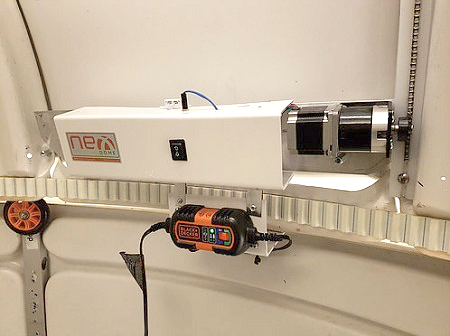Update: November 2021: The Observatory saw “first light” on November 14th, 2021 when I took a nice shot of the Elephant Trunk Nebula (IC 1396). Over the following month gradually I got all the various systems working remotely and was able to do the first remote imaging session a few days before Christmas.
I made a series of videos about the whole process which you can see on my channel on YouTube or watch them on my video page here on the site.
The Holy Grail of photographic astronomy is to have a permanent observatory with everything all set up, perfectly aligned, and telescope, mount, and camera all more or less ready to go at the flip of a few switches. Such things are relatively expensive but not incredibly so, so when an opportunity arose to do this, I jumped at the chance. Some nights it takes me more than 3 hours to assemble the telescope, cameras, guide scope, dew heaters, put it all on the mount and get the mount aligned to the sky, achieve focus, get auto-guiding working and everything all talking nicely to the master computer.
Well, that's three hours I'd rather spend shooting images so wouldn’t it be nice to have a permanent installation somewhere? You bet!
The Plan
There are a number of vendors out there that have dome-style products that you can buy and assemble on site. There are plans circulating around the internet and companies that will build or ship you parts for a roll-off roof designed observatory as well. Which to choose?
I was familiar with the roll-off roof designs from my days at the Cincinnati Astronomical Society where four of the five observatories they had were that style.
I knew domes from my days at the Cincinnati Observatory Center and have to say that for observational astronomy, domes leave a lot to be desired in that you can't really see much sky at all through the dome slit and you don't truly get that "I'm out beneath the stars" feeling that is so cool. You also miss any meteors that may streak by!
With the roll-off roof design, your scope is much more exposed to the elements of dew (which can be amazingly heavy here in South Carolina) and wind. It doesn't take more than a slight gust of wind to smear an image to the point of unusability so this is a big consideration.
Ultimately I decided to get a dome. The roll-off roof observatories are fairly permanent structures and since I was putting this on land I don't actually own, you never know what is going to happen in the future and theoretically, the domes can be disassembled and relocated.
It’s Automatic!
Dome shutter open/close motor
Another thing about the domes is that there already exists software that will coordinate the operation of the dome with the movements of the telescope and mount inside. There’s a motor that turns the dome and another to open and close the dome shutter so the control software has to know where the telescope is pointing and then maneuver the dome opening so the telescope has a clear view of the sky, and then keep it there throughout the session as the telescope tracks across the sky during the hours’ long exposure run.
The fact that this technology exists (it’s even free!) opens up the possibility that you could run the entire observatory from a remote location which seems appealing, maybe as a “next-level” stage of development. It’s actually done quite a bit, it’s just that the people doing it know a lot more than I do!
Concrete Idea
Another thing I know almost nothing about is concrete, which my last contact with was in the early 90s when I mixed up two and a half bags of Quickrete to put up my old C-Band satellite dish.
You can’t just plop one of these domes down on the dirt; it needs to be secure to the ground so it won’t blow away in a hurricane and it needs to be level. Seems like a ten foot square reinforced concrete pad would do nicely! So now I have to find somebody who knows their way around concrete and isn’t going to cost me a fortune. Angie’s List was useless but I have a couple feelers out.
Pier Review
The telescope mount usually sits on a super-solid vertical column referred to as “the pier” instead of the tripod legs you use for portable situations. These things are sunk into bedrock on large installations (like the ones you see in their own permanent buildings) but in my situation I’m going to have to bolt it to the concrete. This means either drilling holes in cement (after its cured) or making some kind of template/form with the bolts in it upside down and in their proper positions sunk into the wet concrete so once dry, the pier can be dropped on top of it with the bolts sticking up through the mounting holes. Then you screw the nuts down and you should be pretty solid.
The other advantage to the pier vs. tripod is that you don’t have to worry as much about the telescope or camera running into the tripod legs which gives you a little more flexibility as you track objects across the sky.
We Need More Power captain!
The observatory site is fairly remote–no electricity or running water so since there are no water-powered telescopes I better come up with some power. As it turns out the people who are into RV traveling have this problem covered with a range of high-capacity, rechargeable batteries with solar panels to keep them charged. 2000 watt-hours seems to be a good amount.
I’ll need to figure out how to mount the solar panels in a good configuration for the Sun and be sturdy in severe weather.
Show me the Data
The last prong to this whole thing is getting the picture data from the telescope. This actually is the most difficult part. As it turns out there is no good way to move that much data over the cellular data services in a reasonable amount of time; you could connect to it and control the observatory just fine this way but retrieving 150 gigabytes of picture data would take a very long time. So I’m looking into cellular modems and how they work to see what kind of responsiveness I can expect from the shooting computer on the scope.
Tight Scope
So while I’m getting all this together I’m working on the scope configuration. The scope that will mostly reside in the observatory will be my RASA 11” scope and when you’re running a remote scope cable management becomes a big issue. Every wire has to be in place and be snag-free no matter which way the telescope moves. So I’ve got it set up in my living room with a stack of velcro wire ties trying to craft the most compact, efficient wiring scheme possible that’s also undoable when I feel like switching the scope out for galaxy season in the Spring or something.
Big project
This is gonna be a fun project—I’ll be blogging about each of the various stages of the project in separate posts.
Bill the Sky Guy
May 5th, 2021





